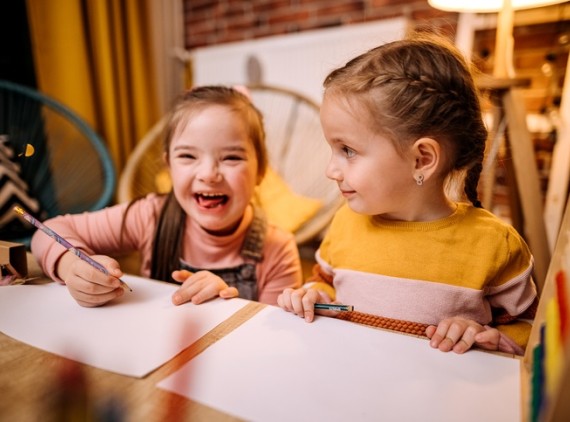We are working toward a world with true acceptance of disabilities. Talking to children about disabilities, including autism, can be challenging. It’s really hard to know what to say sometimes. Here are some tips for talking about autism with children who don’t have autism.
Keep it simple. Use clear language.
Talk about autism openly instead of avoiding the word
“Autism” is not a bad or negative word. It is a natural way that humans can differ from one another. Talking about autism helps us understand and support autistic people.
Share what we know about autism
- Autism is a brain-based difference that impacts the way people behave and interact with others.
- Autistic people may have a hard time talking, making friends and playing with others. They may like to talk a lot about their favorite things, and they may have a hard time asking about other people’s interests. Autistic people may move their arms or bodies in different ways.
Debunk common myths about autism
- Myth: Autistic people don’t feel emotions.
- Truth: While autistic people can have a hard time reading emotions and social cues from others, autistic people care deeply about others and feel the same range of emotions.
- Myth: Autistic people don’t want friends.
- Truth: Autism may impact a person’s ability to make friends and often doesn’t properly reflect their desire to have friends. Share with your child that many autistic people want to have friends but may have a hard time saying, “Hi,” or playing with others.
- Myth: Autistic people cannot speak.
- Truth: Some autistic people are non-speaking. Others can speak and communicate verbally quite well. Remind your child that there are lots of ways to communicate with others. For example, sign language, drawing and even playing are forms of communication.
Talk about commonalities, and be inclusive.
- Autistic kids often have similar interests (e.g., Roblox or Minecraft) to kids without autism. They may enjoy similar activities, such as swimming or playing tag.
- Encourage your child to find shared interests with a friend or classmate who has autism. Maybe they both really enjoy learning about outer space or playing with cars.
- Model inclusion in your own life. Showing your child that you accept and include others in your life who are different than you is one of the best ways to encourage your child to be inclusive. If you don’t know autistic people, consider looking through media created by autistic people. For example, there are many talented autistic artists who have art shows online.
Talk about accommodations rather than focusing on deficits.
- We all need help sometimes. Teaching your child to ask for help when they need it helps them learn to offer help to others. Offering help without judgement is the goal.
- Our world was built for neurotypical people, and autistic people often need extra supports. These supports help them access the same opportunities as people without autism. For example, autistic students may receive support services at school. These services help ensure autistic youth can participate in school just like other kids.
Kids have a lot of questions, and we might not always have the answer. It’s okay (and encouraged) to tell your child that you don’t know and then learn more together. We are all together on this journey toward acceptance!

